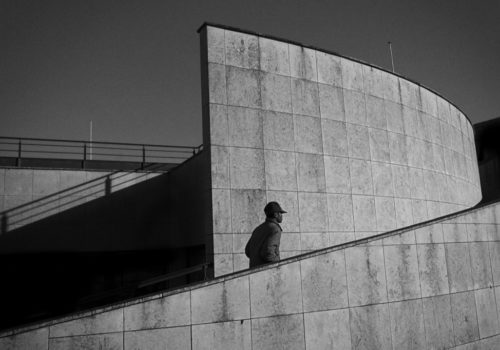To believe in the power of images in spite of everything, in a world saturated with screens, to place a bet on the capacity of some of them to get out of the stream and shine a light on our society, to persist in opening things up is part of the DNA of Médecins du Monde. Since its creation, the association has set itself two missions, “Provide Care and Bear Witness”. Caring, listening, advising, comforting, these are dealt with every day at twenty reception centres in France. Bearing witness is another battle, an equally arduous mission so much so that it has become difficult to make those, the most vulnerable, visible again, those that society wants to remove from the landscape and push to the edges of our consciousness. For many years now, Médecins du Monde has shown its intention to give prominence to the whole population of men, women and children who live on the margin. In 2001, for the association’s 25th anniversary, Gerard Rondeau led a long photographic campaign in about fifteen countries where the association is involved. Other projects followed. The installation “Women after Assault” by Lâm Diuc Hiêm, in 2010, on the violence done to women. The twelve giant portraits of “Let’s Look precariousness in the Face” by Denis Rouvre,were shown on the square in front of the Hôtel de Ville de Paris in 2014.
Through the years, these projects have always been driven by the desire to bear witness of the shameful state of our society, while not losing sight of the dignity to which everyone has a right. Certainly, these photographic exhibitions have not, as a matter of course, changed the deep-seated prejudices, or the unfortunate status of those who were photographed. The impact of the images has not always led to an immediate correction of the injustices and aberrations of the world in which we live. But, for all that, is it necessary to give way to disappointment? It is necessary, on this topic, to listen to the enlightened words of Dork Zabunyan, professor of cinema at the University of Paris 8, who for years has asked himself questions about the way images write history: “We cannot predict the power of the image. Precisely because that power most often lies in a sensitive unknown where we are projected , in the unforeseen meaning that it invites us to explore, suspending fortuitously our ways of seeing and thinking.”
Here we are in 2017 and the question “What can image do?” remains topical as Médicins du Monde celebrates thirty years of battling social injustice in France. Let’s remember: it was in 1986 that the first centre for free care opened its doors in the Rue du Jura in the south of Paris. Thirty years later, while France is the throes of an electoral campaign, that will decide on future issues, the association, once again, has chosen to think that photography can constitute, if not a driving force, at least a participation in the public debate. Why photography rather than another medium? Because to recall Susan Sontag, “When the question of memory arises, photography is more incisive. Memory proceeds by step by step analysis: its basis is the single image.” Throughout history, we have been able to contest this still image that sometimes runs the risk of being a stereotype. We have rightly pointed out a certain photographic attractiveness of distress that allows the endless renewal of emphatic images in the memory banks of the collective unconscious: the prints of mother and child revive with sometime bad taste the images of the pietà, the portraits of beggars with waxy faces whose challenging dramatics was set by the Spanish baroque painters . “Bad as it is, the world is potentially full of good photographs”, said the American photographer Dorothea Lange, creator of Migrant Mother and icon of humanist photography in the 1930s.
Giving six photographers the care of bringing a new way of looking at the most destitute, the poorly housed, the isolated minors, the migrants, those damaged by life, Médecins du Monde is conscious that it is urgent, once again, to give credit to an image that complicates reality rather than simplifying it. An image that enriches and expands our understanding of events rather than impoverishing and parodying them. To do this, the association called on photographers with very different profiles – Cedric Gerbehaye and Henk Wildschut are documentarists, Valérie Jouve is a visual artist , Claudine Doury, Denis Rouvre and Alberto Garcia-Alix are primarily portraitists. They are French, Belgian, Spanish and Dutch. They bring an artist’s view of today’s society, exempt from clichés and sweet sentimentality. They work like poets of the world and in no way prevents them from striking the mind. On the contrary. The images they present are associated with texts . But just as the words don’t illustrate the pictures, the pictures don’t illustrate the words. It is up to each of these modes of expression to play its part in the score that is being played here, a part that Susan Sontag, better than all others, has been able to define: “The stories can bring us to understand. The photographs do another thing, they haunt us.”
Natacha Wolinski
Natacha Wolinski is a journalist and an author specialising in photography. She lives and works in Paris.
Mise au Poing, 30 ans de combat contre l’exclusion
From 10th February to 18th March 2017
Topographie de l’art
75003 Paris
France
http://www.topographiedelart.fr/
















